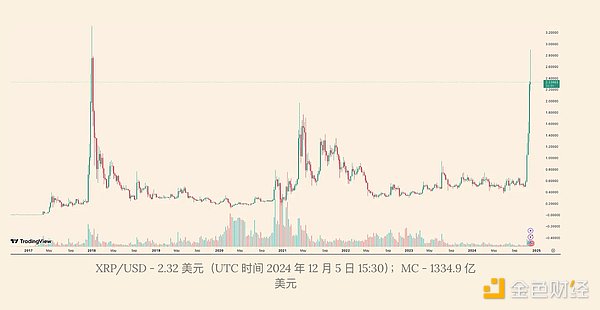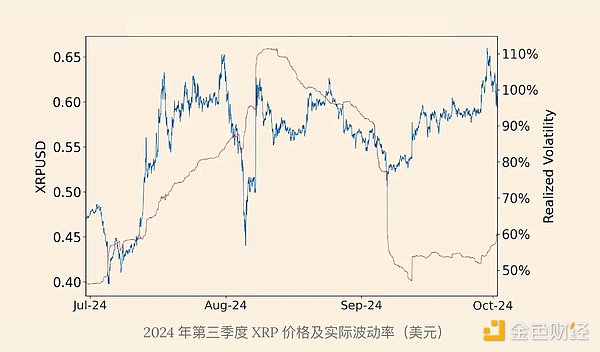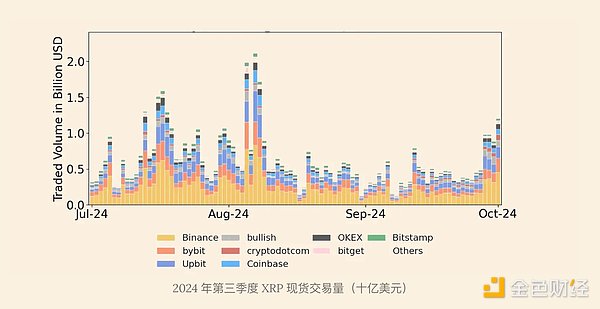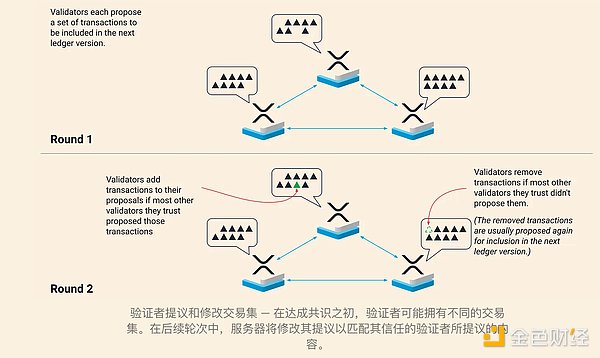Author: insights4vc Source: substack Translation: Shan Ouba, Golden Finance
In the past week, the price of XRP has risen by about 60.96%, from $1.46 to $2.35, with a market value of more than $130 billion. This article will briefly analyze the historical development of Ripple (the company behind XRP), its ecosystem, and the latest progress in the tokenization and regulatory participation of real-world assets (RWA).
Ripple was founded in 2013 as OpenCoin and later renamed Ripple Labs. As a pioneer in blockchain technology, Ripple focuses on cross-border payments and decentralized finance (DeFi). At the heart of the Ripple ecosystem is the XRP Ledger (XRPL), a distributed ledger developed by David Schwartz, Jed McCaleb and Arthur Britto in 2011 to provide efficient, scalable and secure global payment solutions, in line with Ripple’s vision of modernizing financial infrastructure.
XRPL’s Latest Developments
• RWA Tokenization Breakthrough: On November 25, 2024, Ripple announced a partnership with Archax, the first digital asset exchange regulated by the UK FCA, to tokenize Abrdn’s £3.8 billion USD liquidity fund using XRPL. This marks the launch of the first money market fund token on XRPL, further consolidating its leading position in real asset tokenization.
• Deepening regulatory engagement: On December 2, 2024, WisdomTree joined Bitwise, 21Shares, and Canary Capital in applying to the U.S. Securities and Exchange Commission (SEC) to launch a spot XRP exchange-traded fund (ETF). This trend reflects XRP’s growing appeal among institutional investors and also indicates the widespread adoption of tokenized financial instruments.
The State of XRP: Q3 2024 Review
Ripple’s quarterly report reveals key developments in XRP and the broader crypto market:
• Clarity of legal status: A court ruled that XRP is not a security, allowing it to be relisted on U.S. and other international exchanges. Ripple’s distinction from XRP is widely recognized.
• Institutional interest surges: Grayscale launched an XRP trust product, while Bitwise, Canary, and 21Shares filed XRP ETF applications. This shows that institutional confidence in XRP continues to rise.
• Macroeconomic impact: The Fed's 50 basis point rate cut triggered a rally in risk assets, and the crypto market rebounded. In addition, the launch of the US Ethereum ETF attracted $552.2 million in inflows.
• Regulatory environment: The SEC appealed part of the ruling in the Ripple case, but acknowledged that XRP itself is not a security. At the same time, countries and regions such as Japan, the UAE, and Hong Kong have adopted more friendly crypto regulatory policies, in stark contrast to US enforcement actions.
• Global Expansion: Ripple receives regulatory approval in Dubai and drives crypto innovation through strategic investments and advocacy.
With crypto ETFs leading market growth and the U.S. presidential election approaching, regulatory clarity and industry maturity will be key to the future development of digital assets.
Core Team Members
• CEO: Brad Garlinghouse
• Co-founder and Executive Chairman: Chris Larsen
• XRP Ledger CTO: David Schwartz
• XRP Ledger Co-founder: Arthur Britto
• Chief Financial Officer (CFO): Jon Bilich
• Chief Legal Officer (CLO): Stuart Alderoty
• Former Co-founder: Jed McCaleb (now Co-founder of Stellar)
Ripple Labs, Inc. (XRP) Financing Overview - Total Financing Amount: US$294.5 million
Financing Rounds:
1. Undisclosed Round
Date: April 11, 2013
Financing Amount: Undisclosed
Investors: Andreessen Horowitz (a16z), Lightspeed Venture Partners, Vast Ventures
2. Seed Round
Date: April 11, 2013
Financing Amount: Undisclosed
Investors: Andreessen Horowitz (a16z), Lightspeed Venture Partners, Vast Ventures
3. Seed Round
Date: May 14, 2013
Raised Amount: Undisclosed
Selected Investors: GV (Google Ventures), IDG Capital
4. Seed Round
Date: November 12, 2013
Raised Amount: $3.5 million
Selected Investors: Core Innovation Capital, Camp One Ventures, IDG Capital, Hinge Capital
5. Series A
Date: November 12, 2013
Raised Amount: $3.5 million
Selected Investors: Core Innovation Capital, Camp One Ventures, IDG Capital, Hinge Capital
5. Series A
Date: December 3, 2014
Raised Amount: $4 million
Selected Investors: Santander
6. Series A
Date: May 19, 2015
Raised Amount: $28 million
Selected Investors: IDG Capital, Blockchain Capital, Digital Currency Group (DCG), Core Innovation Capital, RRE Ventures, CME Ventures
style="text-align: left;">Date: October 6, 2015
Raised Amount: US$4 million
Selected Investors: Santander, CME Ventures, Seagate Technology
7. Series B
Date: September 15, 2016
Raised Amount: US$55 million
Selected Investors: SBI Investment, Accenture, Santander, CME Ventures, Seagate Technology, Hinge Capital
8. C Round Financing
Date: December 20, 2019
Company Valuation: USD 9.8 billion
Raise Amount: USD 200 million
Selected Investors: Tetragon Financial Group Limited, SBI Investment, Bossanova Investimentos, Route 66 Venture
Token Economics
XRP is the native asset of the XRP Ledger (XRPL), created in 2012 with a fixed total supply of 100 billion, all pre-mined.
• Of these, 80 billion are allocated to Ripple Labs and 20 billion are allocated to the founding team members.
• In order to stabilize the market and manage holdings, Ripple deposited 55 billion XRP into an escrow account in 2017, releasing up to 1 billion XRP per month, with an estimated release cycle of 55 months.
• Unused XRP will be re-locked to extend the release time. As of December 2024, Ripple still holds approximately 37.24 billion XRP in escrow.
Ripple's stablecoin RLUSD
Ripple originally planned to launch the stablecoin RLUSD on December 4, 2024, but it has been postponed pending regulatory approval. Ripple is working with the New York State Department of Financial Services (NYDFS) to meet strict regulatory requirements and maintain high operating standards.
RLUSD Overview:
• First announcement time: April 2024
• Asset support: Fully backed by US dollar deposits, short-term US Treasury bonds and cash equivalents.
• Purpose: RLUSD is an enterprise-grade, compliance-first stablecoin designed to complement Ripple's cross-border payment solutions, operating alongside XRP.
• Market Outlook: With the stablecoin market expected to grow to over $2.8 trillion by 2028, RLUSD is considered an important contributor to this rapidly expanding field.
Key Indicators (December 5, 2024)



XRP Ledger: A Detailed Overview
XRPL is different from traditional Proof of Work (PoW) or Proof of Stake (PoS) blockchains. It adopts a federated consensus model, which allows validators to reach a consensus on the state of the ledger without mining or staking. The consensus protocol is designed to improve efficiency, reduce latency and reduce computational overhead, thereby achieving fast transaction finality.
Validator Network and Unique Node List (UNL)
The XRPL network consists of more than 109 validators distributed around the world. A subset of these validators make up the Unique Node List (UNL), which is essential for reaching consensus. The UNL consists of 31 trusted validators, including entities such as Arrington XRP Capital, Bifrost Wallet, Ripple Labs, and XRPScan. While any entity can operate a validator and issue UNL, the default UNL is heavily influenced by Ripple Labs and the XRP Ledger Foundation.
Centralization Issues:
The default UNL, which relies on the curation of influential organizations, raises questions about centralization. Critics argue that the selection process for trusted validators is not fully permissionless and could undermine the decentralized ethos of blockchain technology. However, supporters emphasize that users can autonomously modify their UNL, allowing for a degree of decentralization based on personal trust preferences.
Consensus Process
The consensus process in XRPL proceeds through iterative rounds where validators propose and agree on sets of transactions to be included in the next ledger version. The process consists of:
Proposal Phase:Validators submit proposed sets of transactions.
Voting Phase:Validators adjust their proposals based on proposals received from UNL peers.
Reaching Consensus:Once a supermajority (usually 80%) of agreement is reached, the set of transactions is applied to the ledger.
Ledger Validation:Validators publish signed verification messages containing the new ledger hash, confirming the consensus.
The mechanism ensures that all participants agree on the state of the ledger and the order of transactions without the need for resource-intensive mining activities.
Transaction Speed, Fees, and Account Reserves
Transaction Speed
There is significant variation in transaction speed and capacity between different blockchain platforms. XRP processes transactions in 3 to 5 seconds, supporting a throughput of approximately 1,500 transactions per second (TPS). Solana achieves sub-second transaction speeds with a maximum capacity of up to 65,000 TPS. In comparison, Bitcoin takes more than 10 minutes per transaction and processes 5 to 6 TPS, while Ethereum processes transactions at 13 to 15 TPS.
Transaction Fees
XRPL has extremely low transaction fees of approximately 0.00001 XRP per transaction. This low cost makes it economically viable for users who frequently make transactions and small payments, in line with the ledger's goal of facilitating efficient value transfer.
Trust Lines and Reserve Requirements
A unique aspect of XRPL is the use of trust lines for token management. To activate a new XRPL account, users must reserve a minimum of 10 XRP. In addition, an additional 2 XRP is required to be reserved for each unique token type held in the wallet. These reserves serve as an anti-spam measure, preventing ledger bloat and discouraging malicious activity.
Trustline functionality:
Bilateral Agreement:Trustlines act as a bilateral credit agreement between two accounts, defining the balance and trust parameters of each token.
Consent-based Token Receipt:They ensure that no account can impose tokens on another account without consent, thereby maintaining user control over the assets received.
Transaction Control:Trustlines can implement features such as freezing assets, requiring authorization for transfers, and setting a "no ripple" flag to prevent unexpected balance adjustments.
Rippling
Rippling in the XRP Ledger (XRPL) facilitates efficient net settlement by adjusting token balances between interconnected trust lines, bypassing direct involvement of issuers. Users can control this feature:
This flexibility ensures that network participation can be tailored to user needs.
Hooks for Enhanced Functionality
Hooks are lightweight WebAssembly (WASM) code that enables programmable functions such as transaction automation, compliance checks, or payment modifications. Hooks are deployed on the Xahau Network (a sidechain of the XRPL) to enhance programmability while maintaining mainnet stability.
EVM-Compatible Sidechains
Developing sidechains compatible with the Ethereum Virtual Machine (EVM) aims to:
Currently in beta, the sidechain uses XRP as gas, positioning XRPL for broader blockchain interoperability.
Native AMM Integration
XRPL’s Automated Market Maker (AMM) enables decentralized token trading and liquidity provision directly on the ledger, supporting:
This native AMM enhances XRPL’s appeal in the DeFi ecosystem.
Detailed Explanation of the XRP Ledger Consensus Protocol

The consensus mechanism is the backbone of the decentralized payment system, ensuring that all participants agree on the state of the ledger without centralized control. The XRP Ledger Consensus Protocol emphasizes efficiency, security, and resilience to failure modes.
Main Features
Ledger Protocol: Ensure consensus on the latest state and transaction order.
Decentralization: Operates without a central authority, avoiding single points of failure.
Robustness: Progress can be made even if participants change or behave improperly.
Safety First: Prioritizes correctness, stopping the process of validating incorrect transactions in the event of an outage.
Efficiency: Avoids the energy-intensive process typical of Proof-of-Work (PoW) systems.
Double Spending Prevention
To prevent double spending, XRPL orders transactions in a deterministic way. Only one of any conflicting transactions will be validated, eliminating the need for centralized dispute resolution.
Ledger Structure
Each ledger version includes:
Current State: Account balances and objects.
Transaction Set: Transactions applied to the previous ledger.
Metadata: Details such as cryptographic hashes and ledger indexes.
This structure creates an immutable history where each ledger contains the complete current state for fast verification.
Trust-based Validation
Participants form a Unique Node List (UNL) and trust validators not to act maliciously. This trust model underpins the security of the system: validators only influence those who trust them.
The consensus process includes:
Proposal: Validators submit sets of transactions.
Voting: Validators adjust proposals based on input from peers.
Consensus: Supermajority agrees to apply to a transaction.
Validation: Validators sign and publish new ledgers.
Fault Tolerance and Security
Validator Failure: Handles up to 20% of faulty validators; stops if failure exceeds 20% but still below 80%, to ensure integrity.
Sybil Resistance: Limits the impact of fake identities based on trust and manual UNL selection.
Invariance Checks: Rejects transactions that violate the rules, such as unauthorized XRP creation.
Adaptive Fee Mechanism
Validators dynamically adjust transaction fees and reserve requirements, balancing accessibility and network protection. Key parameters include base transaction fees, account reserves, and owner reserves, with decisions reached via median voting.
Enhanced Liveness: Negative UNL
To maintain progress during disruptions, Negative UNL temporarily excludes unavailable validators, adjusts quorum thresholds, and reintegrates them upon recovery. This feature ensures continuity without compromising security.
Ripple: Regulatory and Legal Developments
Ripple has faced regulatory challenges throughout its operating history, reflecting the complexity of navigating the evolving legal landscape for blockchain and digital assets.
Key Milestones:
May 5, 2015: Ripple was fined $700,000 by the U.S. Treasury Department’s Financial Crimes Enforcement Network (FinCEN) for Bank Secrecy Act violations, including operating as an unregistered Money Services Business (MSB). Ripple agreed to implement compliance measures and enhance its protocol.
June 13, 2016: Ripple receives a BitLicense from the New York State Department of Financial Services, becoming the fourth company to receive the license.
September 2017: Blockchain company R3 filed a lawsuit against Ripple to enforce an agreement to purchase 5 billion XRP for $0.0085. Ripple countered that R3 was speculating as XRP soared in value. The dispute was settled in September 2018 under undisclosed terms.
February 2020: The Financial Times reported that Ripple's main partner MoneyGram received $50 million from Ripple before adopting XRP-based liquidity tools. Ripple provides these tools for free and provided subsidies totaling $8.9 million in the fourth quarter of 2019. XRP sales are considered a major driver of Ripple's profitability.
December 22, 2020: The U.S. Securities and Exchange Commission (SEC) charges Ripple and its executives Christian Larsen and Brad Garlinghouse with raising $1.3 billion through an unregistered securities offering involving XRP. Ripple disputes the charges, and a court later limits the SEC’s ability to obtain the defendants’ extensive bank records.
July 2023: In a landmark ruling, a U.S. District Court rules that XRP sold in programmatic trading on cryptocurrency exchanges does not constitute a security under the Howey test. However, institutional sales and financing involving XRP can be considered securities. Judge Analisa Torres issued the ruling after two years of litigation.
October 2023: The SEC drops its lawsuit against Ripple executives Garlinghouse and Larsen, marking a partial resolution of the case.
June 2024: Ripple reveals that its legal defense against the SEC has exceeded $100 million, highlighting the financial pressures of prolonged regulatory scrutiny.
Conclusion
XRP’s recent surge in market value to $50 billion reflects renewed interest, but questions remain about its long-term institutional adoption and regulatory challenges. Ripple’s advances, including its tokenized finance initiatives and ETF applications, indicate progress, but also face obstacles, particularly in navigating complex legal and global frameworks. While the SEC’s ruling clarifies XRP’s status in some cases, uncertainty remains, highlighting the need for cautious optimism about its role in the evolving financial ecosystem.
 JinseFinance
JinseFinance








